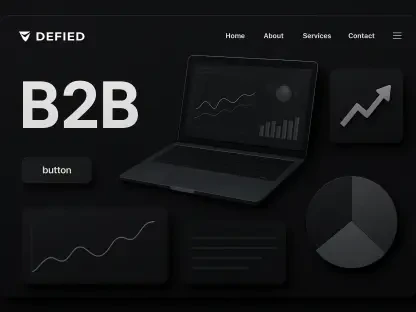Small businesses are often burdened with the complexities and financial strains associated with fragmented and overpriced sales and marketing tech stacks. For many of these smaller enterprises, the challenge lies in utilizing a collection of disconnected tools for essential business functions such as customer relationship management (CRM), email marketing, workflow automation, and lead capture. The reliance on multiple systems creates a tangled web of logins, data silos, pricing confusion, and unexpected upgrade costs, all of which significantly impede efficiency and productivity.
The Cost of Fragmentation
Burdens of Disconnected Tools
Jon Ferrara, the CEO of Nimble, highlights that small businesses typically have to manage various disjointed platforms, creating unnecessary complications and expenditures. Many companies begin with a CRM solution but soon find themselves needing separate tools for email marketing, sales outreach, and workflow automation. This approach results in high costs while failing to provide seamless integration, leading to inefficiencies and fragmented teams that hinder business growth. The need for multiple logins and the struggle to keep track of disparate sources of information further exacerbate the issue, creating a workflow that is anything but streamlined.
The financial implications are also significant. As small businesses strive to maintain operations, they often encounter unexpected upgrade costs and subscription fees that may not have been initially anticipated. Each tool comes with its own set of costs, making financial planning more complex and potentially leading to budget overruns. The absence of a unified system means data is often siloed, inhibiting comprehensive views of customer interactions and sales progress. These silos prevent businesses from harnessing holistic insights needed for strategic decisions.
Impact on Business Efficiency
The fragmented tech stack not only drains resources but also negatively affects team collaboration. When various tools are not integrated, communication between departments becomes strained, and workflows become disjointed. This lack of coordination can hinder innovative efforts and slow down project completion, ultimately affecting overall productivity and customer satisfaction. Teams may find themselves duplicating efforts or missing crucial information, leading to errors and inefficiencies that a more unified approach could avoid.
Operational inefficiencies can also be seen in the time spent navigating multiple platforms to perform routine tasks. Employees must switch between numerous programs just to complete their work, wasting valuable time that could be better spent on more productive activities. Minimizing the number of platforms used through a unified system would streamline operations, allowing employees to focus on their core responsibilities and improve service delivery to clients.
The Unifying Solution
Nimble’s Integrated Approach
Nimble offers a solution with its unified sales and marketing platform, designed to alleviate the burdens associated with managing multiple tools. By integrating various functions into one comprehensive platform, Nimble aims to streamline processes, reduce costs, and enhance collaboration across teams. Key features of Nimble include CRM and deal pipelines, email outreach and automation, lead enrichment, LinkedIn and social prospecting, workflow and task automation, custom workflow boards, email marketing campaigns, and web lead capture. This consolidation allows businesses to manage all essential functions under one roof, eliminating the inefficiencies and fragmented workflows created by disconnected systems.
In addition to streamlining operations, Nimble’s unified platform reduces the financial strain experienced by small businesses. Instead of dealing with multiple upgrades and subscription fees, businesses pay for a single, cohesive tool that offers comprehensive functionalities. This cost-effective approach not only simplifies budgeting but also ensures that businesses can access all the necessary features without facing prohibitive costs. Nimble provides an all-in-one solution that covers the spectrum of sales and marketing needs, setting small businesses up for success.
Enhancing Team Collaboration
Rebecca Wettemann, CEO and Principal Analyst at Valoir, supports Nimble’s approach, noting that the unified platform eliminates silos, thus promoting better team collaboration. With built-in automation and a shared customer view, businesses can drive meaningful interactions, improve efficiency, and accelerate growth. Team members can access a single source of truth, enabling cohesive strategies and coordinated efforts, leading to improved outcomes and more productive meetings.
By leveraging Nimble’s integrated tools, businesses can foster a collaborative environment where all members have the information they need to make informed decisions. Real-time data sharing and automated workflows ensure that everyone stays on the same page, reducing miscommunication and fostering a culture of teamwork. The ability to track and manage customer interactions across departments enriches the team’s understanding of customer needs, enhancing service delivery and customer satisfaction. These improvements in collaboration can result in innovative solutions and faster project completions, propelling business growth.
Financial Implications
Comparisons and Cost Savings
The article highlights the high costs associated with using multiple fragmented tools, providing examples such as Salesforce ($100/user/month), ZoomInfo ($417/user/month), and HubSpot Marketing ($846/month). Small businesses often find themselves overwhelmed by these expenses, which can detract from other critical investments. Nimble positions itself as a cost-effective alternative by integrating these functionalities within a single platform at a lower cost, thus simplifying technology management for small businesses.
Viveka von Rosen, founder of Beyond the Dream Board, shares her positive experience with Nimble, stating that the platform simplified her sales and marketing tools while cutting costs and reducing the time spent managing multiple apps. Nimble enabled her to focus on building meaningful relationships rather than dealing with fragmented tools. This cost-efficiency is crucial for small businesses that need to allocate resources effectively. By reducing technology expenses, these businesses can re-invest in growth initiatives and operational enhancements, further driving their success.
Streamlined Technology Management
In addition to reducing direct costs, Nimble’s integrated approach simplifies the complexities associated with managing multiple technology tools. Businesses no longer need to navigate the maze of upgrades, subscriptions, and compatibility issues inherent in a fragmented tech stack. The streamlined management not only saves time but also reduces the likelihood of technical mishaps and operational disruptions. Businesses benefit from consistent updates and cohesive support, bolstering their ability to stay ahead in a dynamic market.
As small businesses streamline their tech stacks with unified solutions like Nimble, they can better manage their workflows, data, and customer interactions. The ease of use and comprehensive functionality offered by Nimble supports a smoother transition for businesses looking to consolidate their tools. Simplified technology management leads to greater productivity, allowing businesses to focus on their core competencies and strategic goals instead of being bogged down by technical challenges.
Future Considerations
Reassessing Tech Stacks
In conclusion, it’s crucial for small businesses to reassess their tech stacks and consider unified solutions to reduce costs, simplify operations, and enhance productivity. The initial step involves evaluating the current technology landscape to identify areas of improvement and potential integrations. Nimble’s robust, integrated platform effectively addresses the pain points of fragmented and expensive tech stacks while streamlining sales and marketing efforts for small businesses. With a unified system, businesses can unlock efficiencies that drive growth and innovation.
Looking forward, the adoption of integrated platforms can be a game-changer for small businesses. These tools allow companies to leverage advanced features without the complexity and expense associated with multiple disconnected systems. The move towards consolidation not only enhances operational efficiency but also positions businesses to better compete in the market. Reviewing the current tech stack and seeking opportunities for integration will help small businesses make informed decisions that promote sustainability and growth in the ever-evolving business environment.
Moving Towards Integration
Small businesses frequently grapple with the complexities and financial burdens brought on by fragmented and overpriced sales and marketing technology stacks. These smaller enterprises often face the challenge of using a collection of disconnected tools for critical business functions such as customer relationship management (CRM), email marketing, workflow automation, and lead capture. Relying on multiple systems results in a tangled web of logins, isolated data silos, pricing confusion, and unforeseen upgrade costs, all of which significantly hamper efficiency and productivity. Each system requires separate user accounts, leading to login fatigue and security concerns. The lack of integration between these tools means that data cannot seamlessly flow from one platform to another, creating inefficiencies. Financial strain becomes evident as the cumulative costs—both initial and recurring—of these disparate systems quickly add up. Additionally, surprise upgrade fees further exacerbate budget constraints, leaving small businesses struggling to manage their tech stacks effectively.









